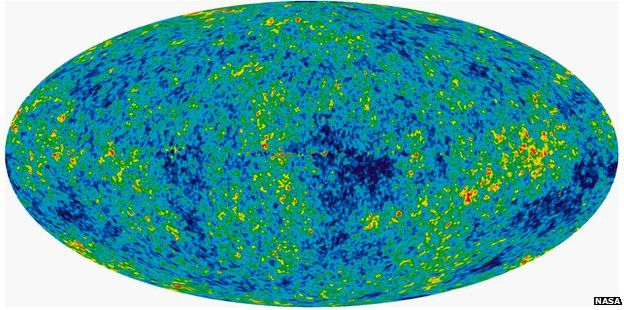Space 'textures' nearly ruled out in WMap study
- Published

The very fabric of space is not as "knotted" as some theories predict it should be, say researchers.
Just after the Big Bang, the Universe began to coalesce into the structure we see today, which in some theories would result in knots or "textures".
The warm glow left over from that is now spread across all of space, and is used to test theories of those moments.
But a close study of this glow reported in Physical Review Letters has found no evidence of these textures.
The cosmic microwave background (CMB), as it is known, is just a few degrees above absolute zero, but it is the minute variations in the glow across the sky that has intrigued astrophysicists.
Crystal clear?
The earliest Universe was an unimaginably dense place, where the laws of physics as we now know them were subject to very different conditions.
The first few instants after the Big Bang gave rise to variations in the dense lump of matter, which now manifest as variations in the CMB.
A space telescope called the Wilkinson Microwave Anisotropy Probe was launched in 2001 to examine those variations.
Studying the detailed maps it has provided is not unlike entering a kitchen and figuring out how the first steps of dinner were prepared based on the distribution of leftover heat.
Nevertheless, such study has provided some insights, shoring up the idea of a vast "inflation" after the Big Bang, adding weight to a model of a Universe rich with dark matter that most astrophysicists agree upon, and finding the first evidence of helium before the first stars formed.
Questions remain, though, about how the fabric of space stretched itself out in those early moments. As the Universe cooled, it underwent a series of "phase transitions", just like water freezing into ice.
Stephen Feeney of University College London (UCL), lead author of the new study, said that the transitions that yielded the space we see today are analogous to the formation of crystals such as diamond or quartz.
"If you cool a liquid very slowly, a regular crystal will form, with the same pattern throughout the entire crystal," he told BBC News.
"When a liquid cools quickly, imperfections in the crystalline pattern can form. Some cosmological theories predict that the Universe itself should be no different.
"However, if you cool the liquid very quickly, the pattern will only be the same over small separations. In between different regions, the patterns won't line up perfectly."
Just as in these "defects" in a crystal, textures are like knots in the structure of space itself.
Some theories that attempt to unify the fundamental forces in nature predict that many textures were formed - and researchers have been scouring the WMap data to find them.
But Mr Feeney and an international team led by UCL cosmologist Hiranya Peiris now say that these knots are unlikely to exist.
"A previous group looked at a particular prominent feature in the WMap data - called the Cold Spot - and concluded that it was likely to be a texture," Mr Feeney said.
First reported in 2007 and published in Science , the study considered a small portion of the sky, using the data available at the time. When the full seven-year data set across the full sky is considered, the story seems different.
"We've shown that when the full WMap data are considered, the texture hypothesis isn't actually favoured," he said.
The analysis, a preprint of which is published online , shows to 95% confidence that theories calling for more than six textures have it wrong - but the team concedes that significantly better data are on the way.
The European Space Agency's Planck satellite, launched in 2009 and due to release a fresh trove of results in the coming months, will provide significantly higher sensitivity and resolution - probably putting an end to the knotty question altogether.
- Published3 October 2006
- Published3 August 2011
- Published6 June 2008
- Published26 December 2010